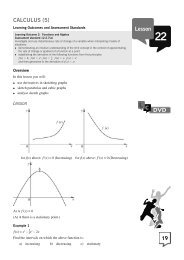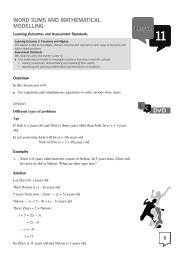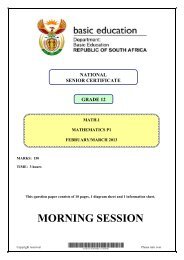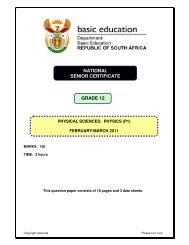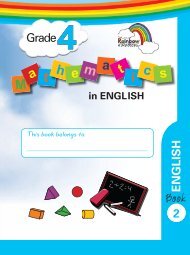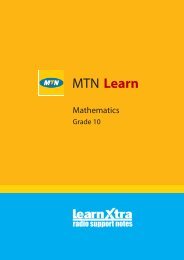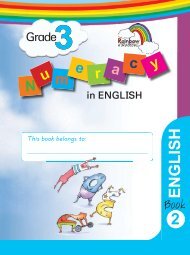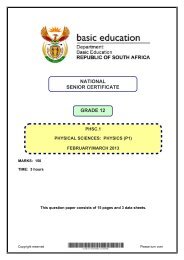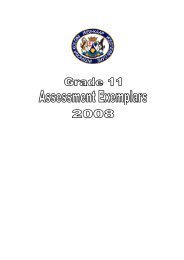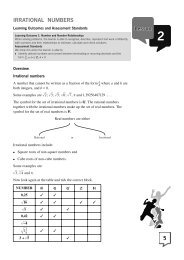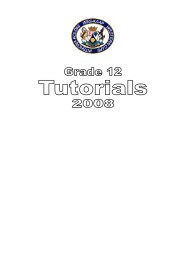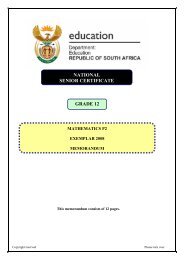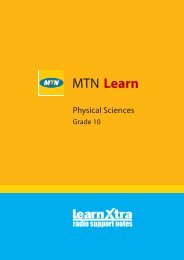Teacher's Guide Module 1 - Maths Excellence
Teacher's Guide Module 1 - Maths Excellence
Teacher's Guide Module 1 - Maths Excellence
Create successful ePaper yourself
Turn your PDF publications into a flip-book with our unique Google optimized e-Paper software.
Suite each learner. It is very important that each learner should work with numbers that<br />
he/she understands, and not be forced to use numbers that are too large and which have<br />
no real meaning for him/ her. Understanding must grow. Give it time. Also do daily oral<br />
work “up and down the Number Line” with those who need it. Start with a number, e.g. 54<br />
and ask learners to add 1-digit numbers or subtract them, e.g. 54 + 4 = ….. Add 1-digit<br />
numbers to the answer each time.<br />
ORAL GROUP WORK<br />
Appoint one learner in each group (or pair) to hold the calculator and be the “Control”.<br />
This learner programmes the calculator to count as required. He/ she presses the = sign<br />
each time the others say a multiple and checks their answers. If they make an error, the<br />
“control” says “Stop” and shows them the correct answer. Counting then continues.<br />
Learners accept correction from a calculator more comfortably than from an adult. It is not<br />
a “big issue”. Change the “Control” often so that each learner gets plenty of opportunity to<br />
count without a calculator. It is a good idea to let “weak” learners hold the calculator. They<br />
feel important telling others when they are wrong, and gain confidence, but make sure that<br />
they also count without the calculator and don’t become lazy! If you have any “live wires”<br />
(hyper-active learners) it may be good for them to have something in their hands – their<br />
attention will also be focused.<br />
Let your groups count while you walk round and listen, or ask various learners to continue:<br />
“Susan, you begin” then, “Peter, you continue” and “Mary, count backwards from ….” etc.<br />
This keeps the learners on their toes. If they are struggling, let the whole group count<br />
softly together. This gives them confidence.<br />
............................................. ACTIVITY 1.2 place value<br />
This is an extremely important concept. The activities are straightforward. Calculator<br />
games can be a very powerful learning tool. Instead of drilling using boring columns which<br />
learners never seem to understand, try telling them to key into a calculator any number,<br />
example 2 345. Ask them to tell you how to get rid of the 3 with one command. They say,<br />
“Key in – 300 =”. Someone may say “Key in + 700 =” Allow them to discuss if this is<br />
correct. (It is!) Play this game often – it’s a fun way of learning place value.<br />
Another calculator game is: “I have 87. How can I make it into 870?” They will say, “Key<br />
in x 10 =”<br />
..........................ACTIVITY 3<br />
ROUNDING OFF<br />
This section can be followed step by step in the learner’s module. Point out the practical<br />
uses of rounding off. It can be used as a quick an easy method to estimate, more or less,<br />
an amount and this is often useful in the “real world”. It can also be used to check answers<br />
and see that they are reasonable.<br />
WORD SUMS<br />
Comparing two or more quantities; Learners may become confused. Make sure they<br />
understand the problem i.e. what information they must supply. Do not tell them how to<br />
find it! Show them that you have confidence in their ability to solve the problem, that you<br />
will give them a reasonable amount of time to do so, and that you are very (genuinely)<br />
interested in how each of them decides to solve the problem.



